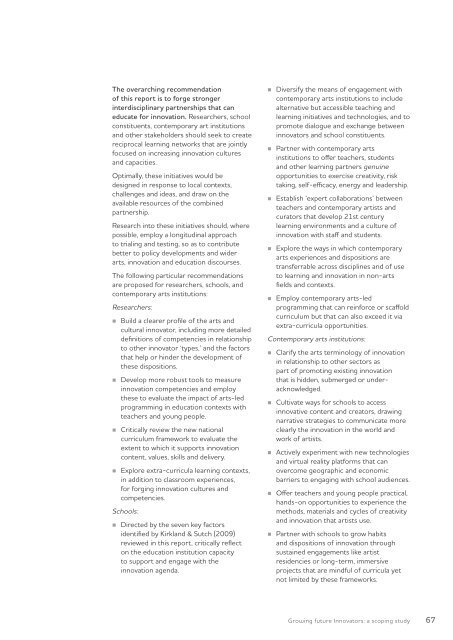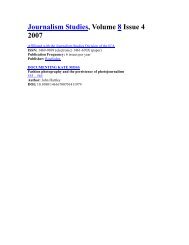GrowinG Future innovators - ARC Centre of Excellence for Creative ...
GrowinG Future innovators - ARC Centre of Excellence for Creative ...
GrowinG Future innovators - ARC Centre of Excellence for Creative ...
You also want an ePaper? Increase the reach of your titles
YUMPU automatically turns print PDFs into web optimized ePapers that Google loves.
The overarching recommendation<br />
<strong>of</strong> this report is to <strong>for</strong>ge stronger<br />
interdisciplinary partnerships that can<br />
educate <strong>for</strong> innovation. Researchers, school<br />
constituents, contemporary art institutions<br />
and other stakeholders should seek to create<br />
reciprocal learning networks that are jointly<br />
focused on increasing innovation cultures<br />
and capacities.<br />
Optimally, these initiatives would be<br />
designed in response to local contexts,<br />
challenges and ideas, and draw on the<br />
available resources <strong>of</strong> the combined<br />
partnership.<br />
Research into these initiatives should, where<br />
possible, employ a longitudinal approach<br />
to trialing and testing, so as to contribute<br />
better to policy developments and wider<br />
arts, innovation and education discourses.<br />
The following particular recommendations<br />
are proposed <strong>for</strong> researchers, schools, and<br />
contemporary arts institutions:<br />
Researchers:<br />
Build a clearer pr<strong>of</strong>ile <strong>of</strong> the arts and<br />
cultural innovator, including more detailed<br />
definitions <strong>of</strong> competencies in relationship<br />
to other innovator ‘types,’ and the factors<br />
that help or hinder the development <strong>of</strong><br />
these dispositions.<br />
Develop more robust tools to measure<br />
innovation competencies and employ<br />
these to evaluate the impact <strong>of</strong> arts-led<br />
programming in education contexts with<br />
teachers and young people.<br />
Critically review the new national<br />
curriculum framework to evaluate the<br />
extent to which it supports innovation<br />
content, values, skills and delivery.<br />
Explore extra-curricula learning contexts,<br />
in addition to classroom experiences,<br />
<strong>for</strong> <strong>for</strong>ging innovation cultures and<br />
competencies.<br />
Schools:<br />
Directed by the seven key factors<br />
identified by Kirkland & Sutch (2009)<br />
reviewed in this report, critically reflect<br />
on the education institution capacity<br />
to support and engage with the<br />
innovation agenda.<br />
Diversify the means <strong>of</strong> engagement with<br />
contemporary arts institutions to include<br />
alternative but accessible teaching and<br />
learning initiatives and technologies, and to<br />
promote dialogue and exchange between<br />
<strong>innovators</strong> and school constituents.<br />
Partner with contemporary arts<br />
institutions to <strong>of</strong>fer teachers, students<br />
and other learning partners genuine<br />
opportunities to exercise creativity, risk<br />
taking, self-efficacy, energy and leadership.<br />
Establish ‘expert collaborations’ between<br />
teachers and contemporary artists and<br />
curators that develop 21st century<br />
learning environments and a culture <strong>of</strong><br />
innovation with staff and students.<br />
Explore the ways in which contemporary<br />
arts experiences and dispositions are<br />
transferrable across disciplines and <strong>of</strong> use<br />
to learning and innovation in non-arts<br />
fields and contexts.<br />
Employ contemporary arts-led<br />
programming that can rein<strong>for</strong>ce or scaffold<br />
curriculum but that can also exceed it via<br />
extra-curricula opportunities.<br />
Contemporary arts institutions:<br />
Clarify the arts terminology <strong>of</strong> innovation<br />
in relationship to other sectors as<br />
part <strong>of</strong> promoting existing innovation<br />
that is hidden, submerged or underacknowledged.<br />
Cultivate ways <strong>for</strong> schools to access<br />
innovative content and creators, drawing<br />
narrative strategies to communicate more<br />
clearly the innovation in the world and<br />
work <strong>of</strong> artists.<br />
Actively experiment with new technologies<br />
and virtual reality plat<strong>for</strong>ms that can<br />
overcome geographic and economic<br />
barriers to engaging with school audiences.<br />
Offer teachers and young people practical,<br />
hands-on opportunities to experience the<br />
methods, materials and cycles <strong>of</strong> creativity<br />
and innovation that artists use.<br />
Partner with schools to grow habits<br />
and dispositions <strong>of</strong> innovation through<br />
sustained engagements like artist<br />
residencies or long-term, immersive<br />
projects that are mindful <strong>of</strong> curricula yet<br />
not limited by these frameworks.<br />
Growing future Innovators: a scoping study 67




![Plebiscite (Riegert chapter) revised FINAL [Feb 14].pdf](https://img.yumpu.com/8710373/1/190x245/plebiscite-riegert-chapter-revised-final-feb-14pdf.jpg?quality=85)